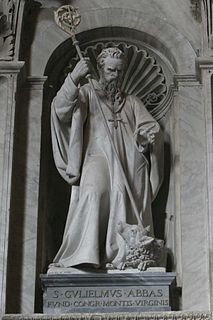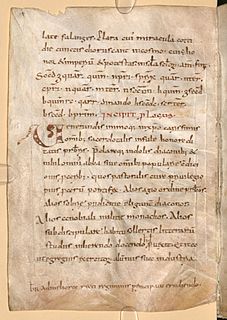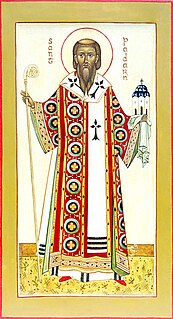
Boniface was an English Benedictine monk and leading figure in the Anglo-Saxon mission to the Germanic parts of the Frankish Empire during the eighth century. He organised significant foundations of the church in Germany and was made archbishop of Mainz by Pope Gregory III. He was martyred in Frisia in 754, along with 52 others, and his remains were returned to Fulda, where they rest in a sarcophagus which has become a site of pilgrimage.
Wilfrid was an English bishop and saint. Born a Northumbrian noble, he entered religious life as a teenager and studied at Lindisfarne, at Canterbury, in Gaul, and at Rome; he returned to Northumbria in about 660, and became the abbot of a newly founded monastery at Ripon. In 664 Wilfrid acted as spokesman for the Roman position at the Synod of Whitby, and became famous for his speech advocating that the Roman method for calculating the date of Easter should be adopted. His success prompted the king's son, Alhfrith, to appoint him Bishop of Northumbria. Wilfrid chose to be consecrated in Gaul because of the lack of what he considered to be validly consecrated bishops in England at that time. During Wilfrid's absence Alhfrith seems to have led an unsuccessful revolt against his father, Oswiu, leaving a question mark over Wilfrid's appointment as bishop. Before Wilfrid's return Oswiu had appointed Ceadda in his place, resulting in Wilfrid's retirement to Ripon for a few years following his arrival back in Northumbria.

Stephen of Ripon was the author of the eighth-century hagiographic text Vita Sancti Wilfrithi. Other names once traditionally attributed to him are Eddius Stephanus or Æddi Stephanus, but these names are no longer preferred or accepted by historians today; modern usage tends to favour "Stephen".

Samson of Dol was a Cornish saint, who is also counted among the seven founder saints of Brittany with Pol Aurelian, Tugdual or Tudwal, Brieuc, Malo, Patern (Paternus) and Corentin. Born in southern Wales, he died in Dol-de-Bretagne, a small town in north Brittany.

Willibrord was an Anglo-Saxon missionary and saint, known as the "Apostle to the Frisians" in the modern Netherlands. He became the first bishop of Utrecht and died at Echternach, Luxembourg.

Brendan of Clonfert, is one of the early Irish monastic saints and one of the Twelve Apostles of Ireland. He is also referred to as Brendan the Navigator, Brendan the Voyager, Brendan the Anchorite, Brendan the Bold. The Irish translation of his name is Naomh Bréanainn or Naomh Breandán. He is mainly known for his legendary voyage to find the “Isle of the Blessed” which is sometimes referred to as “Saint Brendan’s Island”. The written narrative of his journey comes from the immram The Navigatio Sancti Brendani Abbatis,.

Saint Giles, also known as Giles the Hermit, was a hermit or monk active in the lower Rhône most likely in the 6th century. Revered as a saint, his cult became widely diffused but his hagiography is mostly legendary. A town that bears his name grew up around the monastery he purportedly founded, which became a pilgrimage centre and a stop on the Way of Saint James. He is traditionally one of the Fourteen Holy Helpers.

Rumwold was a medieval infant saint in England, said to have lived for three days in 662. He is said to have been full of Christian piety despite his young age, and able to speak from the moment of his birth, professing his faith, requesting baptism, and delivering a sermon prior to his early death. Several churches were dedicated to him, of which at least four survive.

Donar's Oak was a sacred tree of the Germanic pagans located in an unclear location around what is now the region of Hesse, Germany. According to the 8th century Vita Bonifatii auctore Willibaldi, the Anglo-Saxon missionary Saint Boniface and his retinue cut down the tree earlier in the same century. Wood from the oak was then reportedly used to build a church at the site dedicated to Saint Peter. Sacred trees and sacred groves were widely venerated by the Germanic peoples.
Heimerad was a German priest and travelling preacher, popularly revered as a holy fool.
Adomnán or Adamnán of Iona, also known as Eunan, was an abbot of Iona Abbey (r. 679–704), hagiographer, statesman, canon jurist, and saint. He was the author of the Life of Columba, probably written between 697 and 700. This biography is by far the most important surviving work written in early-medieval Scotland, and is a vital source for our knowledge of the Picts, and an insight into the life of Iona and the early-medieval Gaelic monk.

William of Montevergine, or William of Vercelli,, also known as William the Abbot, was a Catholic hermit and the founder of the Congregation of Monte Vergine, or "Williamites". He is venerated as a saint by the Roman Catholic Church.
Wulfstan the Cantor, also known as Wulfstan of Winchester, was an Anglo-Saxon monk of the Old Minster, Winchester. He was also a writer, musician, composer and scribe. Wulfstan is most famous for his hagiographic work Vita S. Aethelwoldi.

Hygeburg, also Hugeburc, Hugeberc, Huneberc or Huneburc, was an Anglo-Saxon nun and hagiographer at the Alemannian monastery of Heidenheim. She is "the first known Englishwoman to have written a full-length literary work" and "the only woman author of a saint's life from the Carolingian period".

Magloire, better known as Saint Magloire of Dol, is a Breton saint. Little reliable information is known of Magloire as the earliest written sources appeared three centuries after his death. These sources claim that he was a monk from Wales who became the Bishop of Dol-de-Bretagne in Brittany during the 6th century, and ended his life on the island of Sark, where he was abbot of a monastery.

Padarn was an early 6th century British Christian abbot-bishop who founded St Padarn's Church in Ceredigion, Wales. He appears to be one and the same with the first bishop of Braga and Saint Paternus of Avranches in Normandy. Padarn built a monastery in Vannes and is considered one of the seven founding saints of Brittany. Padarn's early vita is one of five insular and two Breton saints' lives that mention King Arthur independently of Geoffrey of Monmouth's Historia Regum Britanniae.
Eigil was the fourth abbot of Fulda. He was the nephew and biographer of the abbey's founder and first abbot Saint Sturm. We know about Eigil primarily from the Latin Life that the monk and teacher of Fulda, Candidus Bruun composed about him after his death.

The Vita Sancti Wilfrithi or Life of St Wilfrid is an early 8th-century hagiographic text recounting the life of the Northumbrian bishop, Wilfrid. Although a hagiography, it has few miracles, while its main concerns are with the politics of the Northumbrian church and the history of the monasteries of Ripon and Hexham. It is one of a collection of historical sources from the late 7th- and early 8th-centuries, along with the anonymous Vita Sancti Cuthberti, the works of Bede and Adomnán's Vita Sancti Columbae, that detail the Christianisation of Great Britain and make the period the best documented period in English history before the age of Alfred the Great.
The Vita Sancti Cuthberti is a prose hagiography from early medieval Northumbria. It is probably the earliest extant saint's life from Anglo-Saxon England, and is an account of the life and miracles of Cuthbert, a Bernician hermit-monk who became bishop of Lindisfarne. Surviving in eight manuscripts from Continental Europe, it was not as well read in the Middle Ages as the prose version by Bede. It was however Bede's main source for his two dedicated works on Cuthbert, the "Metrical Life" and the "Prose Life".

The Ragyndrudis Codex is an early medieval codex of religious texts, now in Fulda in Germany, which is closely associated with Saint Boniface, who, according to tradition, used it at the time of his martyrdom to ward off the swords or axes of the Frisians who killed him on 5 June 754 near Dokkum, Friesland. This long association has given the codex the status of a contact relic.













